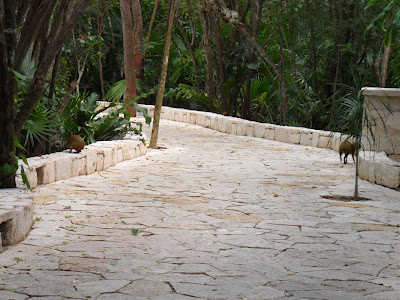
There was a guard at the gate that checked everyone in and out of the resort. We did not leave the premises unaccompanied except to take this picture.

We saw lots of geckos, iguana and a small brown rodent called an agouti on the resort property.
We walked up and down this path every day to get to the beach and the restaurants. The food was buffet style and very good. I especially enjoyed all the fruits, salads and vegetables to choose from. We sampled all the mini desserts too, of course.

This was the bridge over a small ravine that took us to the beach. It had uneven boards that we tripped on a few times even with the sign that warned us about it!

The pool was beautiful, but no one was ever in it. We tried to get in one day and realized it was colder than the ocean! Nice to look at though.
This was the cool ceiling in the lobby where we listened to live bands every night.
 We took a guided tour to see the ruins at Chichen Itza which has 1.2 million visitors each year. The guide was very knowledgeable and spent the 2 hours getting there teaching us about the history.
We took a guided tour to see the ruins at Chichen Itza which has 1.2 million visitors each year. The guide was very knowledgeable and spent the 2 hours getting there teaching us about the history. This pyramid is called El Castillo or The Castle. It stands about 98 ft high and consists of a series of nine square terraces, and 91 steps to the top on each face of the pyramid. At the base of the balustrades of the northeastern staircase are carved heads of a serpent.
On the Spring and Autumn Equinox in the late afternoon, the northwest corner of the pyramid casts a series of triangular shadows against the western balustrade on the north side that evokes the appearance of a serpent wriggling down the staircase. Some have suggested the effect was an intentional design by the Maya builders to represent the feathered-serpent god Kukulcan. Archaeologists have found no evidence to support such an assertion.
Archaeologists have identified thirteen ballcourts for playing the Mesoamerican ballgame in Chichen Itza, but the Great Ball Court to the northwest of the Castillo is by far the most impressive. It is the largest and best preserved ball court in ancient Mesoamerica. It measures 551 by 230 ft. The parallel platforms flanking the main playing area are each 312 ft long. The walls of these platforms stand 26 ft high; set high up in the center of each of these walls are rings carved with intertwined feathered serpents.
 The game was probably similar to racquetball where the aim is to keep the ball in play. In the most widespread version of the game, the players struck the
ball with their hips, although some versions allowed the use of
forearms, rackets, bats, or handstones. The ball was made of solid rubber and weighed as much as 9 lbs, and sizes differed greatly over time or according to the version played.
The game was probably similar to racquetball where the aim is to keep the ball in play. In the most widespread version of the game, the players struck the
ball with their hips, although some versions allowed the use of
forearms, rackets, bats, or handstones. The ball was made of solid rubber and weighed as much as 9 lbs, and sizes differed greatly over time or according to the version played.This is my picture of the Temple of Warriors (left), but I found an aerial picture on Wikipedia (below) to show the columns better.

Along the south wall of the Temple of Warriors are a series of what are today exposed columns, although when the city was inhabited these would have supported an extensive roof system.
This structure is theorized to have been an observatory with doors and windows aligned to astronomical events, specifically around the path of Venus as it traverses the heavens.
This is a small temple known as La Iglesia, "The Church" decorated with elaborate masks.
Thanks to Wikipedia for some of the info that I couldn't recall on my own.








No comments:
Post a Comment